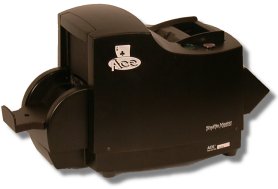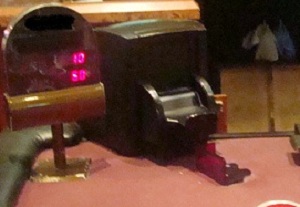[Note. There is an updated version of this post that you might want to read before/after you read this post: Three Card Poker Hole-Card Play: Update #1 -- It's got all the math that's fit to eat!]
Of all the proprietary games out there, the most reliable money-maker for the AP by far is “Three Card Poker.” The reason is simple – poorly trained dealers, bad equipment and weak procedures lead to dealers exposing their hole-card. While there is no edge on the “Pair Plus” bet if the dealer exposes the hole-card, there certainly is an edge for the AP on the main Ante/Play part of the game. In fact, if the dealer consistently exposes the hole-card, then the house edge swings from 3.373% for the house to an edge of 3.483% for the player.
The strategy is simple enough. The normal strategy is to fold any hand that is Q63 or lower and make a Play bet with any hand that is Q64 or higher. Seeing one card, the strategy changes significantly, however the final hole-card strategy is trivial enough to be learned in a matter of minutes.
Hole-card strategy for Three Card Poker:
-
If the hole-card is 2, 3, 4, 5, 6, 7, 8, 9, T, J, then always make the Play bet.
-
If the hole-card is Q, then play Q92 or higher, otherwise fold.
-
If the hole-card is K, then play K92 or higher, otherwise fold.
-
If the hole-card is A, then play A92 or higher, otherwise fold.
There are many variations to handle special cases. For example, if you see an undetermined face cards (J, Q, or K), then play QJ5 or higher, otherwise fold. Just like blackjack, dealers and pit crew should know this basic hole-carding strategy to better be able to identify suspicious play.
Identifying APs who are hole-carding is fairly easy. Just look for players who are making substantial wagers on the Ante/Play and rarely wager on the Pair Plus bet. When they do wager on the Pair Plus, it is a small amount compared to the main wager that’s used as a cover move. Look around the table, are other players also playing this way? If so, someone may be signaling the table. If a suspected player also plays a lot of bust hands (less than Q high), then with high confidence the player is hole-carding.
When Three Card Poker first started becoming popular in 2001 and 2002, no one on the casino side understood the magnitude of this vulnerability. This was the golden age of hole-card play in this game. I played it a lot during the period 2002-2005, though my play was recreational. There was an opportunity at nearly every casino that offered the game and APs ate it up. It almost became déclassé to play against it – it was just too easy. Among APs the game got the nickname “One Card Poker.”
One of the prime causes of all of this grief was the shuffler – the Shuffle Master Ace (pictured below). As you can see, the cradle is about 3 inches above the felt. When the cards are dealt, the dealer takes out packets of 3 cards and delivers them to each player. Then the dealer takes a pack and drops it in front of himself. Without a safe procedure and careful supervision, the dealer’s bottom card (hole-card) was often clearly visible.

Below is a recent picture (December, 2011) I took at a Las Vegas strip casino illustrating this problem. Note that the shuffle discard tray sits directly below the cradle, making it impossible to quickly bring the cards down to the felt. This is not a rare find. Often blackjack tables are converted to proprietary games, and the blackjack remnants are left on the table. If you start looking around, you will see this type of vulnerable set-up everywhere.

For an interesting thought experiment about just how bad this is, imagine dealing six-deck blackjack from a shoe designed like this. With the cards 3 inches above the ground and the discard tray below the cradle, no table games manager would allow it. In a game where the dealer’s hole-card has to be hidden from view, this shuffler works directly against game security. Would any table games manager stand for this set-up on a blackjack table? Why are proprietary games any different?
Many solutions to fix this hole-card problem have been tried. The basic fix is to teach and enforce good dealing habits. However, using equipment that encourages hole-card exposure has led to only marginal progress. That is exactly why this opportunity can still be readily found.
A couple of procedural fixes were tried. The first fix is simple – the dealer does not receive his packet of cards until all players have made their play/fold decision. The dealer’s cards remain perched in the cradle, and only after every player has acted does the dealer give himself his cards. This is certainly a safe way to handle the problem. Without a hole-card, no hole-card can be exposed. Many casinos use this method. In every case, this has completely solved the hole-card issue. But there’s a catch.
The problem is that the shuffler does not commence shuffling the next deck until all the cards are removed from the cradle and the remainder of the current deck is ejected. This causes a delay in delivering the next round because the shuffler has not yet finished shuffling. Though the delay may seem small, it is compounded by the number of hands per hour, the number of players, the total wagers and all the other facets of the time/motion equation. Simply put: a slower game eats at profits. Is this degradation of profits less than the potential loss that APs could inflict?
The second fix is also simple, but much less reliable. Most casinos muck the player’s cards if he folds the hand, in other words, folded cards are never exposed. This fix is to expose all hands, even folded ones. For this fix to work, staff must know basic hole-card strategy. It then stands out when the AP plays his 5-3-2 off-suit (if the dealer’s hole-card is 2-J) while folding A-5-3 off-suit (if the dealer’s hole-card is an Ace). This policy makes hole-card players very uncomfortable; it is game protection by intimidation.
The problem is that APs can still play in a hit-and-run fashion. Moreover, at many casinos very little notice is taken of odd plays. For example, an AP can use a cover act as an out-of-town drunk. This will make any odd play appear okay. It follows that even with the additional information about the player’s folded cards, unless the house knows what to look for, the procedure has no value. For this reason, I have encountered this solution used by only a small minority of casinos.
Another approach is to hand deal the game – just get rid of the shufflers. I know of several casinos that do this. The hole-card issue remains and may be even worse. Improperly trained or poorly supervised dealers may end up exposing even more hole-cards (2 or 3, rather than 1); some casinos that used this procedure have been hit very hard by APs. But, if a casino trusts its dealers on blackjack, then they can probably be trusted to hand deal Three Card Poker.
The final solution I know about is the one recently implemented by Shuffle Master. They completely abandoned the Shuffle Master Ace and brought out a new shuffler, the iDeal shuffler. This shuffler has a cradle that sits below table level, so the cards are lifted and can be safely and reliably dealt by a trained dealer. The issues with the iDeal shuffler will have to wait for another post.
Three Card Poker illustrates the new world of game protection for proprietary games. This is one game and one problem and a decade’s worth of issues with no end in sight.


